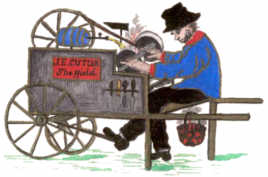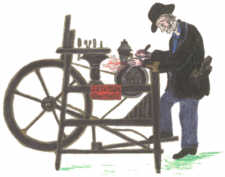Page
revise 18 January 2004
EDWARD LAW
ARMS, CRESTS & MONOGRAMS
ALBUMS
It is an unfortunate fact that many
of those who collected crests did not record their names in their
albums; unfortunate because the name and location of the
collector often adds interest and may assist in research.
Identifiable material in albums
often points to the location of the collector and sometimes to
their background or interests. Most of the names which do appear
convey nothing, but occasionally they are recognised.
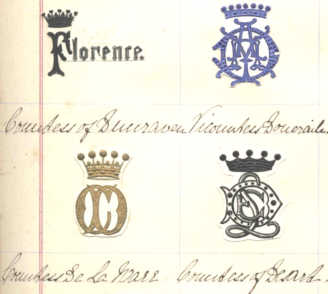 The collection contains an album inscribed
Louise Bassano, June 1875, a name unusual enough to suggest a
link with Studio Bassano. This noted Victorian photographic
studio was founded by Alexander (Allesandro) Bassano who did
indeed have a daughter Louise. Clearly the correspondence of the
Studio provided the material for this prestigious crest
collection.
The collection contains an album inscribed
Louise Bassano, June 1875, a name unusual enough to suggest a
link with Studio Bassano. This noted Victorian photographic
studio was founded by Alexander (Allesandro) Bassano who did
indeed have a daughter Louise. Clearly the correspondence of the
Studio provided the material for this prestigious crest
collection.
Louise does not appear to have
inherited her father’s artistic abilities: the contents are
arranged alphabetically in an album of squared pages. Alongside
is a section of a page from D, with crests of four titled ladies,
all probably customers of the studio.  Only
at the back in a miscellaneous section is the album enlivened by
a little competent hand decoration. The choice of subject
(entwined nautical serpents?) is a little bizarre, though not
ineffective.
Only
at the back in a miscellaneous section is the album enlivened by
a little competent hand decoration. The choice of subject
(entwined nautical serpents?) is a little bizarre, though not
ineffective.
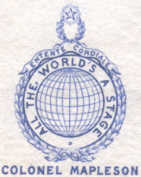 The largest album in the collection (28cm x
39cm) lacks any inscription but carries, on the front free
pastedown, a crest of Colonel Mapleson, its location suggesting
that the album belonged to him or a descendant.
"Colonel" Mapleson was a leading Victorian operatic
impresario, and
The largest album in the collection (28cm x
39cm) lacks any inscription but carries, on the front free
pastedown, a crest of Colonel Mapleson, its location suggesting
that the album belonged to him or a descendant.
"Colonel" Mapleson was a leading Victorian operatic
impresario, and 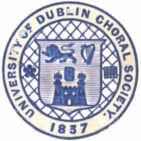 the design of the crest, which is very
similar to that used by the Garrick Club, would be well suited to
his business activities.
the design of the crest, which is very
similar to that used by the Garrick Club, would be well suited to
his business activities.
The contents of this plain album
are exceptionally clean, of a very good quality and nicely
presented. There is not, however, any strong musical bias which
might have been expected; apart from the two crests shown here
there is one other for 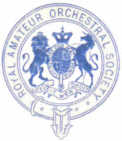 the Royal Society of Musicians of Great
Britain. Nor does the collection contain the crests of the London
theatres: Kings; Her Majesties; and Haymarket with which Mapleson
was involved. The collection appears to be of the early years of
the twentieth century and as Mapleson died in 1901 it may well be
that the album was that of one of his children or grandchildren.
the Royal Society of Musicians of Great
Britain. Nor does the collection contain the crests of the London
theatres: Kings; Her Majesties; and Haymarket with which Mapleson
was involved. The collection appears to be of the early years of
the twentieth century and as Mapleson died in 1901 it may well be
that the album was that of one of his children or grandchildren.
The collection contains two very
interesting albums, an interest which might be greatly increased
if the collectors could have been identified. The material in
both suggests strongly that it came from trade sources. One
collection, in a battered Marcus Ward & Co. album, was
probably from the firm of JENNER
& KNEWSTUB. It contains
a large proportion of opulent crests, including material not seen
elsewhere, and its significance would have been enhanced if a
name had enabled a definite attribution. Jenner & Knewstub's
output has been identified from samples and descriptions in the
collection. The quality of the material is so outstanding that it
was difficult to select the few which are shown here, and it is
really deserving of a page on its own. For some other examples of
Jenner & Knewstub's crest output see HERALDIC and ARTS.
The identity of PAB of Kings Road,
Brighton, is not known. The crest is executed in metallic colours
and the shading at the foot, from deep to pale purple, is unusual
and attractive. There appears at one time to have been a great
vogue for comic monograms; the letters YP depicted here are
typical of the many contrived forms, but the detail and execution
is of the highest quality. Arms of Queen Victoria are plentiful,
being found in almost every album, but the example here is
superb, and was probably executed to grace an invitation to a
royal event.
The second album does not have the
same high proportion of opulent crests, but it does contain a
good deal of material which was originated by James Macmichael.
Some of his work is recognisable from the frontispieces which he
produced for the albums of Stanley Gibbons (see FRONTISPIECES).
 Again there are many contrived monograms;
some treated with such panache that they are miniature works of
art. When the initials are actually printed as a legend it is
fairly clear that they were intended for sets or sample sheets to
advertise the publisher's capabilities. Without the manuscript
inscription one would hardly have taken the name Macmichael from
the pleasing rustic scene above, or from several others wich are
also identified as Macmichael.
Again there are many contrived monograms;
some treated with such panache that they are miniature works of
art. When the initials are actually printed as a legend it is
fairly clear that they were intended for sets or sample sheets to
advertise the publisher's capabilities. Without the manuscript
inscription one would hardly have taken the name Macmichael from
the pleasing rustic scene above, or from several others wich are
also identified as Macmichael.

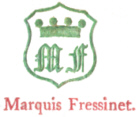 This album
contains over seventy traditional, simple, crests executed in the
normal raised ink, but with the name printed below in plain
print, i.e. not in raised ink. This treatment has not been seen
elsewhere and it may be that they were part of the printer's or
diestamper's archive, to check that the correct die was used for
bespoke stationery.
This album
contains over seventy traditional, simple, crests executed in the
normal raised ink, but with the name printed below in plain
print, i.e. not in raised ink. This treatment has not been seen
elsewhere and it may be that they were part of the printer's or
diestamper's archive, to check that the correct die was used for
bespoke stationery.
The album also contains three
pictorial crests, shown below, all bearing the name Cutler. It is
difficult to see that these could have had any practical use;
again they were probably samples displaying the virtuosity of the
craftsman. Perhaps J E Cutler was the engraver. They serve now,
in their detail, as an historical record.
Neither of the albums are the
luxury items which one might have expected to house collections
of the principals of the firms, but might have belonged to
employees or their children.

Three sumptuous crests in the
'Jenner & Knewstub' album. Only two are named: top left
Duchess of Cardigan and bottom, Sir - Read: actually Reade,
baronets, of Shipton Court, Oxfordshire.
Return to HOME
or to TOPICS PAGE
 The collection contains an album inscribed
Louise Bassano, June 1875, a name unusual enough to suggest a
link with Studio Bassano. This noted Victorian photographic
studio was founded by Alexander (Allesandro) Bassano who did
indeed have a daughter Louise. Clearly the correspondence of the
Studio provided the material for this prestigious crest
collection.
The collection contains an album inscribed
Louise Bassano, June 1875, a name unusual enough to suggest a
link with Studio Bassano. This noted Victorian photographic
studio was founded by Alexander (Allesandro) Bassano who did
indeed have a daughter Louise. Clearly the correspondence of the
Studio provided the material for this prestigious crest
collection.  Only
at the back in a miscellaneous section is the album enlivened by
a little competent hand decoration. The choice of subject
(entwined nautical serpents?) is a little bizarre, though not
ineffective.
Only
at the back in a miscellaneous section is the album enlivened by
a little competent hand decoration. The choice of subject
(entwined nautical serpents?) is a little bizarre, though not
ineffective. The largest album in the collection (28cm x
39cm) lacks any inscription but carries, on the front free
pastedown, a crest of Colonel Mapleson, its location suggesting
that the album belonged to him or a descendant.
"Colonel" Mapleson was a leading Victorian operatic
impresario, and
The largest album in the collection (28cm x
39cm) lacks any inscription but carries, on the front free
pastedown, a crest of Colonel Mapleson, its location suggesting
that the album belonged to him or a descendant.
"Colonel" Mapleson was a leading Victorian operatic
impresario, and  the design of the crest, which is very
similar to that used by the Garrick Club, would be well suited to
his business activities.
the design of the crest, which is very
similar to that used by the Garrick Club, would be well suited to
his business activities.  the Royal Society of Musicians of Great
Britain. Nor does the collection contain the crests of the London
theatres: Kings; Her Majesties; and Haymarket with which Mapleson
was involved. The collection appears to be of the early years of
the twentieth century and as Mapleson died in 1901 it may well be
that the album was that of one of his children or grandchildren.
the Royal Society of Musicians of Great
Britain. Nor does the collection contain the crests of the London
theatres: Kings; Her Majesties; and Haymarket with which Mapleson
was involved. The collection appears to be of the early years of
the twentieth century and as Mapleson died in 1901 it may well be
that the album was that of one of his children or grandchildren.
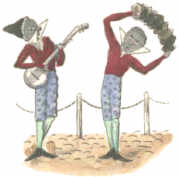

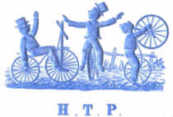
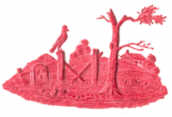

 Again there are many contrived monograms;
some treated with such panache that they are miniature works of
art. When the initials are actually printed as a legend it is
fairly clear that they were intended for sets or sample sheets to
advertise the publisher's capabilities. Without the manuscript
inscription one would hardly have taken the name Macmichael from
the pleasing rustic scene above, or from several others wich are
also identified as Macmichael.
Again there are many contrived monograms;
some treated with such panache that they are miniature works of
art. When the initials are actually printed as a legend it is
fairly clear that they were intended for sets or sample sheets to
advertise the publisher's capabilities. Without the manuscript
inscription one would hardly have taken the name Macmichael from
the pleasing rustic scene above, or from several others wich are
also identified as Macmichael. 
 This album
contains over seventy traditional, simple, crests executed in the
normal raised ink, but with the name printed below in plain
print, i.e. not in raised ink. This treatment has not been seen
elsewhere and it may be that they were part of the printer's or
diestamper's archive, to check that the correct die was used for
bespoke stationery.
This album
contains over seventy traditional, simple, crests executed in the
normal raised ink, but with the name printed below in plain
print, i.e. not in raised ink. This treatment has not been seen
elsewhere and it may be that they were part of the printer's or
diestamper's archive, to check that the correct die was used for
bespoke stationery. 
